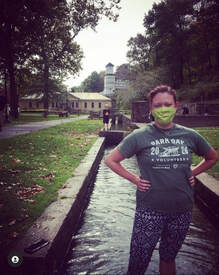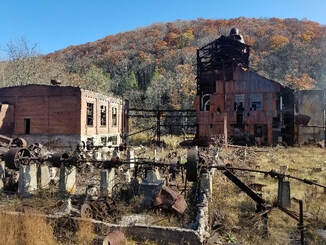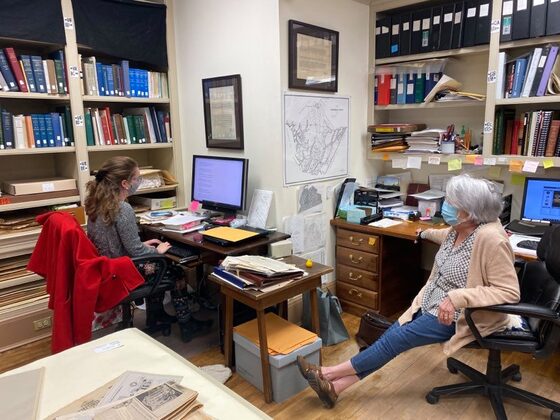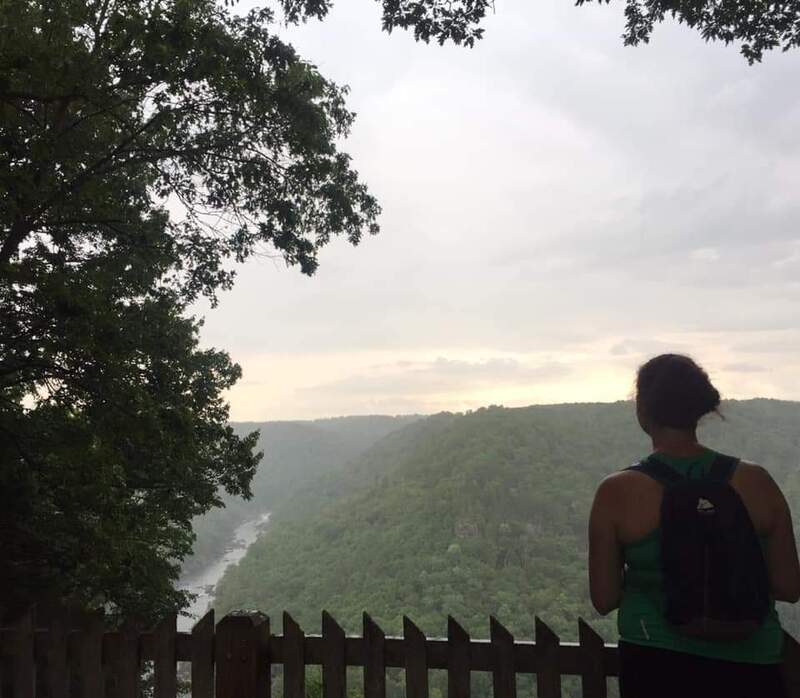Happy Earth Day: Sustainability at the North House MuseumBy AmeriCorps Member - Abi Smith Since the first Earth Day celebration in 1970, each April 22nd is an opportunity to reflect on environmental action and sustainability. As a historical society, we have a unique role to play in promoting sustainability. We like to joke that we’re always thinking in the past, especially when we deep dive into our research (or are running late). However, historical organizations also have a responsibility to consider future generations. If our mission is to preserve the diverse history and culture of the Greenbrier Valley, then sustainability is an inherent part of our mission statement. I decided to take some time this earth day to consider some ways in which we at the Greenbrier Historical Society could be more intentional in promoting sustainability.
 The issue of sustainable collection storage is particularly important in the communities of the Greenbrier Valley. The Valley experiences flooding disasters on a regular basis. Natural disasters, like flooding, can result in the loss of priceless information from private and public collections, as well as family documents. Sustainable collection storage would mean creating disaster plans and storage facilities that are less at risk to destruction. It might also mean working with local communities to create digital copies of private and family collections in case these physical items are destroyed. So how can small organizations work to promote sustainable collections.  One step that we can take here at the North House Museum is to be more intentional in our collecting. Did you know that many museums only display 10-20% of their collection? This means that large portions of a museum’s collection are sitting in climate-controlled storage. Although new additions to our collection are exciting, the constant growth of an organization’s collection is not always sustainable. A sustainable collection is one that an organization has enough staff, space, and time to manage. Museum collections are not intended to hold every artifact of a community’s history, but rather are to be curated collections that can be reworked as the needs of the organization changes. Here at the Greenbrier Historical Society, we are working to improve our collecting to focus on our scope of the Greenbrier Valley. This sometimes means deaccessioning exciting collection items that have no relation to our scope, like historic copies of the New York Times. We can deaccession these kinds of items with the knowledge this information will be preserved in other institutions with a more accurate collecting scope. Preservation of information is a key part of our mission statement, but so is education. Museums are well suited for education as they are designed to communicate to diverse groups of people. Often, environmental sustainability is taught through the science of climate change. However, as a history focused organization, we also have space to teach sustainability. We can teach about historic land use and land management practices. In fact, our newest exhibit opening in May, The Road to Plenty, examines Native American land use and management, and how those practices changed with colonization. We can also teach about the impact of industry on West Virginia’s environment. The lumber and coal industries had a major impact on the land of the Greenbrier Valley, and the effects of these industries still impact our communities. By including discussions of sustainability into the programming we already have, we can provide a framework to help guests better understand the importance of sustainable practices.
The field of museums has been slow to develop sustainable practices. However, as more institutions begin to consider these issues, more museums are beginning to implement sustainability standards. The issues of environmental sustainability can seem overwhelming, particularly for small organizations. It may even make us question our understanding of how museums should operate. However, small, concrete actions will help shift museum and public practices and values to ones that help future community enrichment.
0 Comments
WV State Park & Forest Adventures Through HistoryBy Executive Director Nora Venezky In 2020 I made it my goal to visit every West Virginia State Park and Forest (There are 45). Little did I know it would become the perfect year to spend as much time as possible outside and in nature. I was very fortunate to have great weather 97% of the time and a few friends in my bubble that joined me on my hikes. If you are not aware, West Virginia State Parks have a few awesome programs to encourage you to visit.  Their VIPP program allows you to collect stamps at each park when you complete the program you get a patch, window decal, and a $25 gift card for use at any park or forest and its FREE to sign up: https://wvstateparks.com/parks/programs/vipp/. They also have a hiking program that is only $15 to register for and you get rewards as you hit different milestones: https://wvstateparks.com/parks/programs/hiking/. There is no time limit on these programs and visiting State Parks is an amazing way to explore West Virginia. It is also amazing how much history you can discover along the way at some of the state parks. Here are a few West Virginia State Parks that had some great history to explore: Droop Mountain Battlefield State Park Droop is in the Greenbrier Valley up in Pocahontas County and worth the quick drive (don’t forget to stop at everyone’s favorite Beartown State Park since its just up the road). This park is part of the Civil War Discovery Trail and is the site of the Battle of Droop Mountain that took place on November 6. 1863. They have a small museum you can visit to learn more about the battle, or you can walk up the iconic lookout tower. I recommend the .5-mile Overlook trail if you want to see Civil War trenches, and a scenic overlook. Watters Smith Memorial State Park This is one of the last parks I visited in December of 2020. It was stunning with the fresh Christmas snow sticking to the trees. Lots of great hiking and mountain biking trails made for a nice hike. Unfortunately, I visited out of season and the historic village was closed down for the season, but I was still able to explore and read the interpretive panels. The museum depicts pioneer life from 1796 to the early 1900s. The land the park is on was first settled by Watters Smith and his wife Elizabeth in 1796. They built a home and raised eight children on the farm. Chief Logan This park gets its name from Chief Logan, a leader of the Mingo people who lived in the area and fought against white settlers who were encroaching on his people’s land and killed members of the Mingo tribe. This park also hosts a museum and other historic sites. After driving through Buffalo Creek to get to the park I appreciated learning more about the of the Buffalo Creek flood that occurred in February 26, 1972 when Pittston Coal Company’s slurry dam burst and unleashed 132 million gallons of waste water killing 125 people. The museum had exhibits on coal mining, railroad history, and more. I enjoyed a hike on Woodpecker Trail, a 2.3-mile easy hike through the woods that was recommended by one of the rangers. There is a great mix of nature and history at this state park. Blennerhassett Island Historical State ParkThis state park is all about history, open from May 1- October 31 this island adventure was a blast! You can get a combo ticket that includes the sternwheel boat ride to the island, a wagon ride around the island, a guided tour of the reproduction Blennerhassett Mansion (yes this is not the original mansion, it was rebuilt using blueprints and historic documentation), and a visit to the Blennerhassett Museum of Regional History. I thoroughly enjoyed the sternwheel boat ride to the island; it was so mesmerizing watching the sternwheel churn the water of the Ohio River. Make sure you plan a whole day to explore the history and maybe stop at a restaurant or brewery in Parkersburg after. Berkeley Springs State Park This was a great trip that I combined with visits to Cacapon and Lost River State Parks. Berkley Springs is an awesome little town with great little shops and restaurants and so much history. It is definitely worth taking your shoes off and soaking in the waters. Long before the first white settlers, Native Americans found benefits in these spring waters. George Washington visited the springs regularly and helped promote the health benefits of the spring waters. Located right in the downtown of Berkeley Springs, there is a museum as well as a spa to enjoy. Carnifex Ferry State Park This hike we ran into some torrential downpours and thunder storms, but luckily, we happened to be passing by a picnic shelter at the time we could take cover in. With overlooks of the Gauley River and some stunning forest views this park quickly became one of my favorites. It was the site of a Union victory during the Civil War on September 10, 1861 that led to the eventual withdrawal of Confederate troops from the Kanawha Valley. There is a small museum that teaches you about the history of the battle and area. Cass Scenic Railroad State Park This park is like stepping back into an old lumber town, rows of company houses, the company store, and the train whistles echoing through the valley. Before our current AmeriCorps Member, Abi smith joined us, she spent a year up at Cass working on the historic interpretation of the park. Getting a personal tour from her brought to life so much of the history of this Greenbrier Valley town. I love visiting the remains of the old mill that was built in 1902 before a fire destroyed it in 1922. It used to employ 2,500 people in its heyday before it closed in the 1960s and fell into disrepair. If you are up for the challenge, I recommend taking a weekend bicycle trip from Caldwell up to Cass along the Greenbrier River Trail (You can camp at Watoga State Park on your way!). These are just a few of the amazing West Virginia State Parks that had a focus on history, but each park has a unique history and something share. I challenge everyone to start planning your next West Virginia State Park adventure today, you will learn a lot, recharge in nature, and get to know our Mountain State a bit better.
|
SOCIAL |
PHONE |
ADDRESS |
814 WASHINGTON ST W
LEWISBURG, WV 24901 |
Experiencing issues with this page? Email [email protected].











 RSS Feed
RSS Feed
